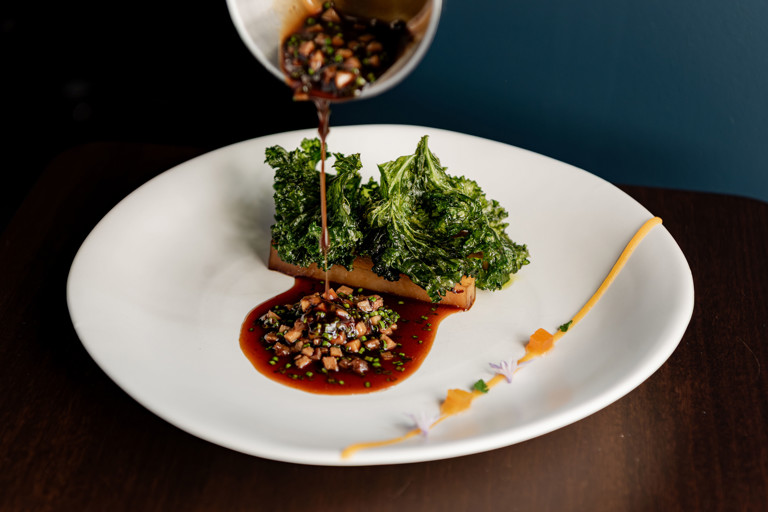Kurobuta pork, Shaoxing rice wine, kale and apricot
- medium
- 6-8
- 4 hours 30 minutes plus overnight resting time and up to 7 hours for slow cooking
The classic pairing of pork and apricot are taken to a new level in this recipe by Tom Tsappis. Pork belly is cooked until beautifully tender and served with poached apricots and a sticky Shaoxing rice wine glaze. Less commonly-used but equally delicious pork tongues are cooked low and slow and served alongside the pork belly.
Ingredients
Metric
Imperial
For the pork belly
- 1 side of pork belly on the ribs
- 80g of tamari
- 250g of cider
For the braised pork tongue
- 1 tsp cloves
- 1 large white onion, quartered
- 1 sprig of rosemary
- 3 bay leaves
- 4 pork tongues
For the Shaoxing rice wine glaze
- 400ml of Shaoxing wine
- 150g of sugar
- 150g of tamari
- 75g of dark soy sauce
- 700g of water
For the poached apricots
- 10 dried apricots
- 100g of water
- 50g of sugar
- 50g of Isomalt sugar
- 1 pinch of saffron
For the apricot fluid gel
- 100g of apricot purée, from above
- 1g of agar agar
For the pork sauce
- pork bones, reserved from above
- 12 star anise
- 50g of black peppercorns
- 20g of fennel seeds
- 200g of sugar
- 500ml of Shaoxing wine
- 6000g of pork and chicken brown stock
For the garnish
- chive flowers
- anise hyssop
- finely chopped chives
Equipment
- Spice grinder
- Squeezy bottle
Method
For the pork, preheat the oven to 160°C fan
Remove the bones from the pork belly and reserve. Blowtorch the skin of the pork to remove any bristles
Roast in the oven for 1 hour
After an hour turn the oven up to 180°C. Cook the pork for another hour
After the second hour has passed, turn the oven up to 200°C. Cook the pork for a third and final hour
Remove the tray from the oven and allow the pork to cool in the tray
Once cool, strain off any liquid, place another tray on top of the pork belly and weigh down with heavy weights. Place in the fridge overnight
The following day, remove the weights from the pork. It should now be uniform in thickness
Slice into 3 cm slices, removing any scruffy edges
For the braised pork tongue, toast the cloves in a pan until fragrant
- 1 tsp cloves
Add to a stock pot alongside the onion, rosemary, bay leaves and pork tongues. Add enough water to cover
- 1 large white onion, quartered
- 1 sprig of rosemary
- 3 bay leaves
- 4 pork tongues
Bring to the boil, skimming any scum that forms, and then reduce to a simmer
Simmer for 4–5 hours until the tongues are tender
Remove from the pot and, whilst hot, peel off the thick outer membrane
Allow to cool, then dice into ½ cm cubes
For the Shaoxing rice wine glaze, combine all ingredients in a pan. Gently bring to a boil, making sure that all of the sugar is dissolved. Once it comes to a boil, set aside and allow to cool
- 400ml of Shaoxing wine
- 150g of sugar
- 150g of tamari
- 75g of dark soy sauce
- 700g of water
For the poached apricots, first cube the dried apricots into 1 cm squares
Add the apricots to a heatproof bowl. Add the water, sugar, isomalt and saffron to a pan and bring to a boil. Once boiling, pour over the dried apricots and leave to cool down
- 100g of water
- 50g of sugar
- 50g of Isomalt sugar
- 1 pinch of saffron
After about 15–20 minutes, once the fruit has completely broken down, pass the purée through a fine sieve to filter out the apricot skins. If the purée seems very thick, add a splash of water to let it down. It should be the consistency of smooth apple sauce. Set aside and leave to cool
For the apricot fluid gel, weigh out 100g of the apricot purée into a pan. Add 1g of agar agar
- 100g of apricot purée, from above
- 1g of agar agar
Bring to just below a boil, whisking all the time. Once it is about to boil, pour out onto a cold oven tray and leave to set into a thin layer of jelly
Once cool, scrape the jelly into a spice grinder and blend into a pipeable gel. Decant to a squeezy bottle
For the pork sauce, brown the reserved pork bones in a little oil in a stock pot. Turning frequently to get a nice even colour on them
- pork bones, reserved from above
Whilst they are browning, toast the spices in a pan until fragrant. Add them to a saucepan with the sugar and Shaoxing rice wine. Reduce this mix by half
- 12 star anise
- 50g of black peppercorns
- 20g of fennel seeds
- 200g of sugar
- 500ml of Shaoxing wine
Deglaze the pork ribs with a splash of the brown stock, making sure to scrape up any crispy bits from the bottom of the pan. Add the remainder of the brown stock and the Shaoxing reduction
- 6000g of pork and chicken brown stock
Reduce until the sauce is shiny, viscous and tastes delicious – this will take a few hours. You will end up with around 2 litres of sauce once the bones and spices are strained out
For the crispy kale, remove just the leaves from the kale with a sharp knife, discarding the stems. Try to keep the leaves as large as possible
- 1kg kale
Heat a few centimetres of oil in a high-sided, heavy-bottomed pan to 160°C
- neutral oil, for frying
Add the leaves and fry until crispy and slightly translucent
Mix together the sugar and salt. Season the hot crispy kale with the sugar-salt mixture and a sprinkle of togarashi
- 50g of sugar
- 50g of salt
- togarashi
To plate, preheat the oven to 150°C fan
Pipe a line of apricot purée along one side of the plate. Dress with the chive flowers, anise hyssop and two pieces of poached apricot.
- chive flowers
- anise hyssop
Place a piece of pork in a frying pan and ladle in enough of the Shaoxing glaze so that it comes halfway up the pork. Reduce the glaze until thick and sticky, turning the pork frequently
Place the pork on a tray, spoon over some of the now thick glaze and finish in the oven for 5 minutes
Add 1 tablespoon chives, 1 tablespoon of pork tongue and 6 tablespoons of pork sauce, and warm through on the hob
Remove the pork from the oven, being careful to keep it in one piece as it will be very soft. Place it on the plate slightly offset to the apricot purée
Pile the crispy kale on top of the pork and finish with the pork sauce tableside
Get in touch
Please sign in or register to send a comment to Great British Chefs.


